The Ducrocq family of cybernetic animals were named “Miso”
These were designated M-1 through to M-5. Some articles refer to “le renard” (French for fox) as “Job” (M-5). M-1 in most cases was referred to as Miso. It probably became M-1 when M-2 was built.
So far, I have seen pictures of 6 different Miso’s. M-1, the round electro-static model, M2-4 are 3 tortoises – Barbara, Cesare, and Felapton. Where does the 6th one come from if there are only 5? The cover of "L'ERE DES ROBOTS" (1953) has , I believe, the first version of Job (le renard – french for fox ) and is referred to as M-5 and looks quite different to the final version of Job (unless, of course, Job was yet to come and would have been M-6?) . Most recent pictures are of the "evolved" M-5 fox.
Biography: from Wiki
Scientifique, journaliste et écrivain français, Albert Ducrocq (9 juillet 1921 à Versailles – 22 octobre 2001) est fils d'Armand Ducrocq, Colonel d'infanterie coloniale et de Germaine (née Adam). Il se marie le 31 juillet 1954 avec Mlle Lucie Roullet avec laquelle il aura 3 enfants: Christine, Chantal et Jean-Claude.
Il fait ses études secondaires à Versailles d'abord au Collège Saint-Jean-de-Béthune puis à l'école Sainte-Geneviève. Il entame ensuite des études supérieures à la Faculté des sciences et des lettres de Paris et à l'Ecole libre de sciences Politiques.
Il fut l'un des pionniers de la cybernétique.
Albert Ducrocq est toutefois beaucoup plus connu en tant que journaliste et écrivain scientifique, dont les talents de vulgarisateur et la passion des récits ont été unanimement reconnus et ont inspiré de nombreuses générations de futurs professionnels comme de passionnés d'astronautique.
Sa propre passion pour ce domaine fit de lui un témoin privilégié des grands évènements de la conquête spatiale. Il s'est notamment rendu en URSS à la fin des années 1950 et a commenté en direct les premiers pas de l'homme sur la Lune pour les auditeurs de la radio Europe 1 en 1969.
Outre ses nombreux ouvrages, il écrivit énormément d'articles, publiés dans les magazines Espace & Civilisation, Atomes, Sciences et Avenir et Air et cosmos, ainsi que dans les pages scientifiques du quotidien Le Figaro.
Google translation
Scientist, journalist and writer French, Albert Ducrocq (July 9, 1921 in Versailles – October 22, 2001) is the son of Armand Ducrocq, Colonel Infantry colonial and Germaine (nee Adam). He married July 31, 1954 with Miss Lucie Roullet with whom he had 3 children: Christine, Chantal and Jean-Claude.
He attended high school in Versailles first at College Saint-Jean-de-Bethune then École Sainte-Genevieve. He began graduate studies at the Faculty of Science and Letters in Paris and the Ecole Libre de Sciences Politiques.
He was a pioneer of cybernetics.
Albert Ducrocq is much more experienced as a journalist and science writer, whose talent for popularizing science and passion narratives were universally recognized and have inspired many generations of future professionals as passionate Astronautics.
Her own passion for this field made him a privileged witness of the great events of the conquest of space. He particularly made in the USSR in the late 1950s and commented live the first steps of man on the moon for listeners of the radio station Europe 1 in 1969.
Besides his numerous works he wrote a lot of articles published in magazines Area & Civilization, Atoms, and Future Science and Air & Cosmos, and in the science pages of the daily Le Figaro.

Ducrocq also built other models, including a calliope (poems and pictures), and a type of model remote-controlled automobile. He also invented a stylus keyboard hookd up to a powered typewriter.
M-1 – Miso
In “Thinking by Machine” by de Latil, on p. 237 he says “ Much the same plan (refering to Grey Walter’s tortoise) is found in “Miso”, the electronic animal created at Versailles in 1952 by Albert Ducrocq using Meccano parts. Instead of being sensitive to light, it is affected by the electric charge of the objects that it approaches. It abhors these objects, even if one of them is in the hands of its maker; thus it is called “Miso”, but it present no great difficulties to transform it into a “Philo.”
It helps to know your Latin when it comes to Ducrocq’s names for his cybernetic zoo. "Miso," signifying hatred of something (hence repulstion), the opposite is "Philo," lover of something (hence attraction).
Miso uses its shell as a capacitive-dome, probably tuned so it is activated (repelled in this case) as ones body get within close proximity to the domed shell without necessarily touching it.
The enlargement of the image and a rough translation of an article gives more of the story. Here goes:-
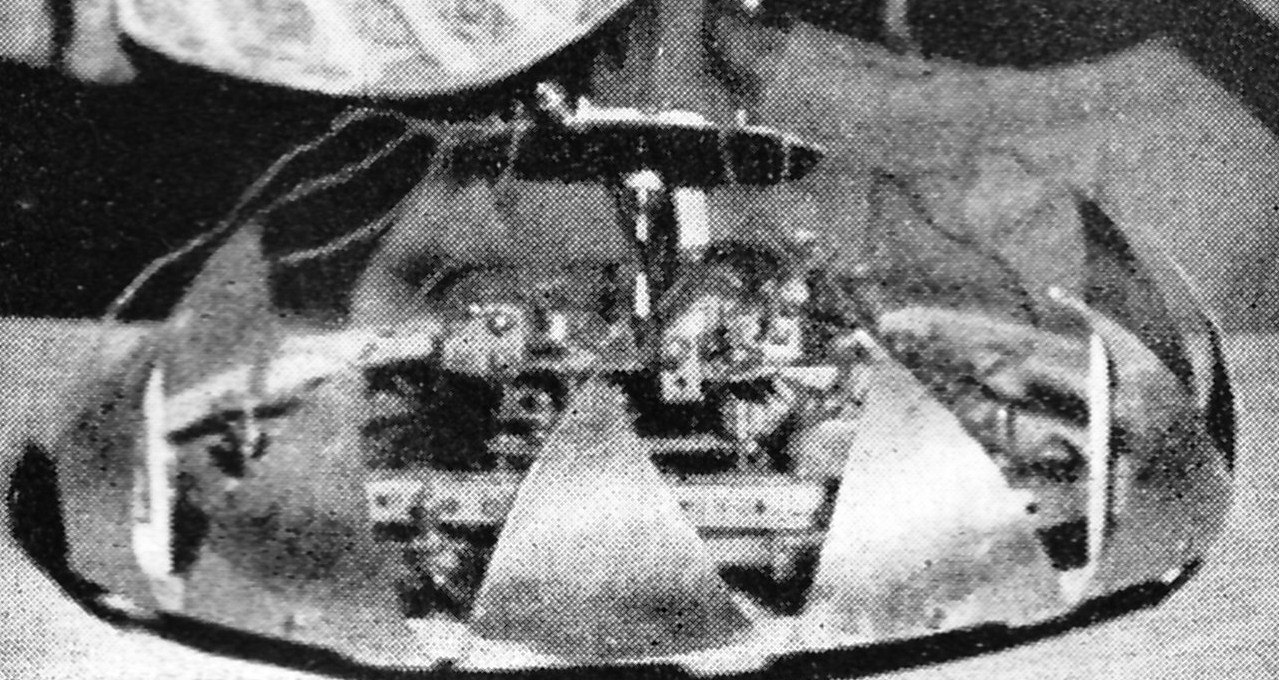
Miso I fut doté d'un sens « capacitif » , le principe étant celui du détecteur de mines :
lorsqu'une plaque métallique est reliée à la grille d'un tube oscillateur, le débit de celui ci se trouve modifié à l'approche de la main aussi bien que d'un corps quelconque, sous la seule condition qu'il ne s'agisse pas d'un isolant électrique parfait. Et avec la variation liés de débit ainsi enregistré il est facile de commander un relais, de tels montages capacitifs ayant d'ailleurs été utilisés dans nombre d'applications pratiques.
D'autre part, nous avons donné à ce Miso I une symétrie circulaire parfaite. L'appareil était porté par quatre roues, disposées respectivement selon les sommets d'un triangle équilatéral et le centre de celui ci : ces quatre roues étaient directrices maintenues parallèles par un système de chaînes, tandis que la roue centrale était motrice, Miso possédant un moteur de marche et un moteur d'exploration à l'instar des tortues de Grey Walter, mais avec la faculté de pivoter sur place avant de partir dans une direction déterminée. En pratique, l'organe sensoriel fut concrétisé par un ensemble de douze papilles périphériques, chacune représentant une
plaque capacitive et le branchement étant tel que lorsque l'animal avançait dans une certaine direction, :étaient « interrogées » les 5 ou 6 papilles se trouvant dans la partie avant. Dans ces conditions, lorsque l'animal « sentait » à distance un obstacle devant lui, il s'arrêtait net et pivotait jusqu'à trouver une nouvelle direction exempte de tout obstacle; cette perception des obstacles à distance et cette rotation pour les éviter étaient assez spectaculaires pour l'observateur non initié.
Dans les réalisations suivantes, nous avons doté les Miso d'organes sensoriels supplémentaires, notamment avec des papilles tactiles, des contacts électriques étant fermés lorsque l'animal venait à toucher un obstacle isolant qu'il n'avait pu flairer à distance. Ensuite, nous avons expérimenté un palpeur de relief destiné à empêcher l'animal de s'engager dans une pente trop forte: la roue centrale était solidaire d'un tâteur qui oscillait entre deux contacts de garde. Ceux ci étaient alors excités lorsque l'appareil s'approchait d'une pente trop forte.
Mais l'élément qui nous apparut le plus intéressant fut bien l'introduction d'un véritable « organe de décision» par lequel pouvait être évoqué un embryon de personnalité. Alors que les tortues se dirigeaient automatiquement vers une faible lumière, tandis qu'au contact d'un obstacle leur moteur d'exploration était automatiquement mis en action dans un sens déterminé, nous avons monté un inverseur sur le moteur d'exploration des Miso, de telle sorte que, rencontrant un obstacle, l'animal puisse tourner à droite ou à gauche, ce choix étant fonction des « souvenirs» de l'animal et pouvant être effectué selon des formules variables. Une des plus intéressantes nous apparut être celle de l'enregistrement des rotations; un disque métallique était déplacé à droite ou à gauche par les rotations de l'animal, de sorte qu'il « sommait» en quelque sorte ces rotations. Ce disque était solidaire d'un contact commandant l'inverseur.
Dans ces conditions, nous avons pu faire en sorte que l'animal « n'aime pas » les rotations. Si, devant un premier obstacle, il a par hasard tourné à droite, il tournera à gauche devant l'obstacle suivant, car la rotation à droite représente pour lui un mauvais souvenir. Et devant un troisième obstacle il choisira le sens auquel est associé sur le disque la moindre rotation. Par exemple, s'il a tourné la première fois de 500 à droite et la seconde fois de 300 à gauche, on peut être sûr qu'il choisira la gauche.
Puis nous avons compliqué la formule en incorporant le principe d'une « habitude » faisant en sorte que lorsqu'une rotation est amorcée elle fasse tourner le disque d'un certain angle representant une sorte de prise en charge. Si sa valeur est de 10 degrés. Il en résulte que trois rotations à droite de 15, 20, et 15 degrés équilibreront plus que largement une seule rotation à gauche de 60 degrés.
Uncorrected translation from Google – good enough to understand how it works.
Miso I was with a sense "capacitive" The principle is that of mine detector:
Where a metal plate is connected to the grid oscillator tube, the flow of this one is modified with the approach of the hand as well as any of a body, under the sole condition that it does act not a perfect electrical insulator. And the variation associated with debit and registered it is easy to order a relay capacitance such schemes have also been used in many practical applications.
On the other hand, we gave this Miso I circular symmetry perfect. The chassis was brought by four wheels, arranged respectively, based on the vertices of an equilateral triangle in the center of this one: these four-wheel steering were kept parallel with a system of channels, while the central wheel was driving with a Miso engine running and an engine crawling like turtles Grey Walter, but with the ability to rotate on the spot before you go in a particular direction. In practice, the sensory organ was solidified by a set of twelve buds devices, each representing one Capacitive plate and the turnout was as if the animal was moving in a certain direction: "interviewed were" 5 or 6 buds located in the front. Under these circumstances, when the animal "remotely sensed" an obstacle in front of him, he stopped and pivoted net until it finds a new direction free from any obstacle, and this perception of distance and obstacles to this rotation were to avoid them quite spectacular for the uninitiated observer.
In the following achievements, we have the Miso additional sensory organs, including touch with papillae, electrical contacts are closed when the animal comes into contact with an insulating barrier that it was unable to sniff out at a distance. Then we experienced a feeler relief designed to prevent the animal from engaging in a slope too strong: Central wheel was attached to a tâteur which ranged between two contacts custody. The latter were excited when the chassis approached from a slope too strong.
But the element that appeared most interesting property was the introduction of a real "decision-making body" which could be referred to an embryo personality. While the turtles were moving automatically to low light, while in contact with a barrier engine exploration was automatically put into action in a specific way, we have an inverter mounted on the engine of exploration of Miso, so that, encountering an obstacle, the animal can turn right or left, depending on the choice "souvenirs" of the animal and can be carried out according to formulas variables. One of the most interesting we appeared to be that of the registration of rotations, a metal disc was moved to the right or left by the rotation of the animal, so that "sommait" somehow these rotations. This disc was attached to a contact Commander reverser.
Under these conditions, we were able to ensure that the animal "dislikes" rotations. If, before the first hurdle, he accidentally turned right, it turns left in front of the obstacle on because the rotation is right for him a bad memory. And before a third obstacle it will choose the meaning that has to disk any rotation. For example, if it turned the first time in 500 right and the second time from 300 to the left, you can be sure he will choose the left.
Then we complicated formula incorporating the principle of a "usual" making sure that when a rotation is primed to do it the hard turn a certain angle representing a kind of care. If the value is 10 degrees. As a result, three rotations to the right of 15, 20 and 15 degrees balance more broadly than one rotation left by 60 degrees.
M-2 to M-4 – Barbara, Cesare, and Felapton.
I have not been able to find any real detail about these three models, in one occurance referred to as 'petit renard' (little fox).
My observation of the photographs suggest a design similar to Grey Walter's M. speculatrix models. They are tricycle based, front wheel steering and drive, twin – not singular photo-electric cells, open-frame shells as collision detectors.
Fortunately I've been able to locate a video clip of these three, and it shows a little of their behaviour, but not enough to draw firm conclusions. (Gaumont link here . You need to register to preview the clips).
M-5 Job – Le electronique renard – The electronic fox.
Early version.
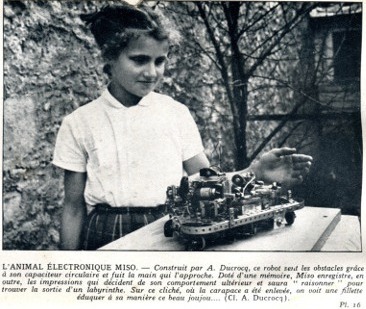
Later version
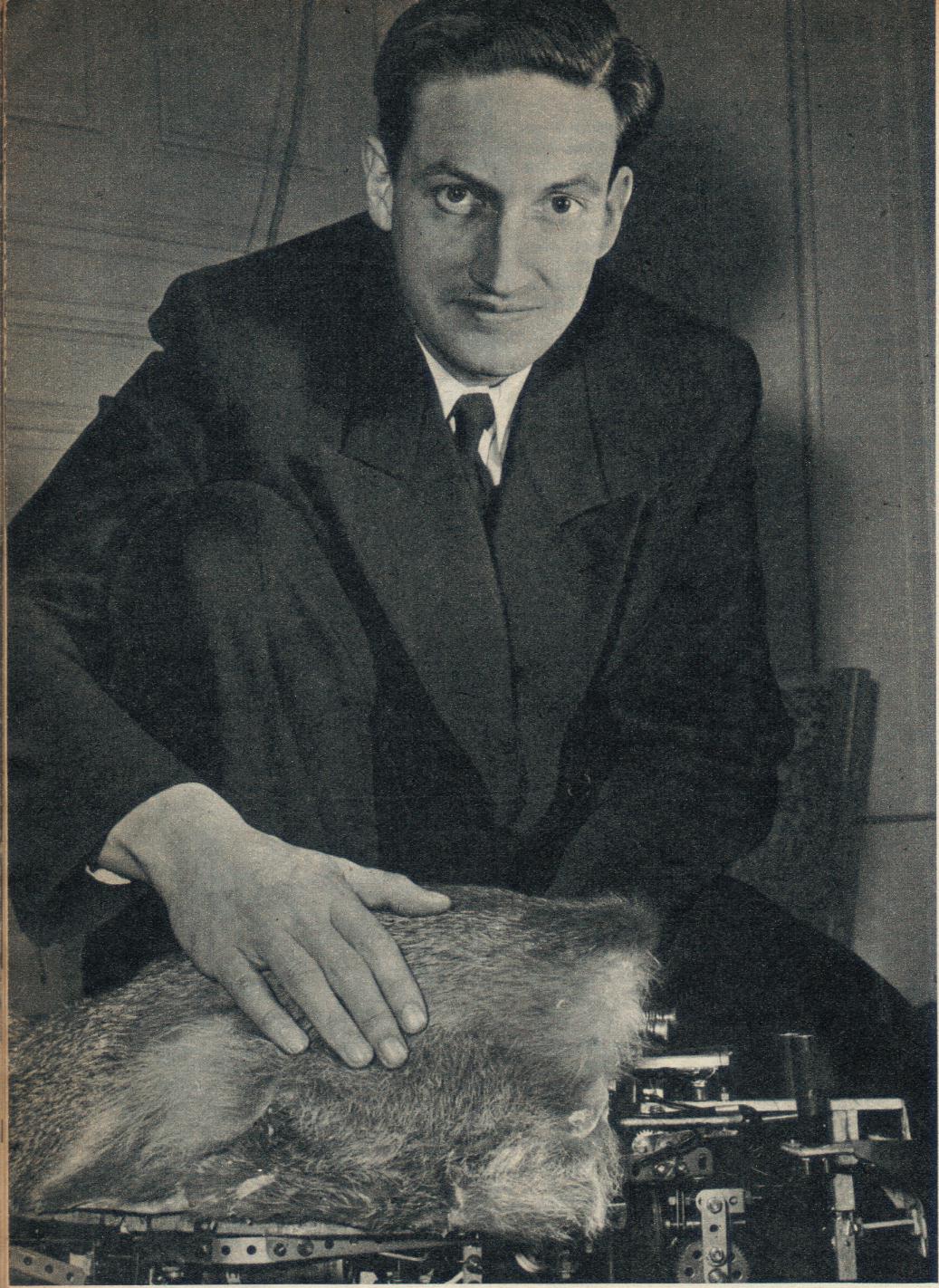

.jpg)
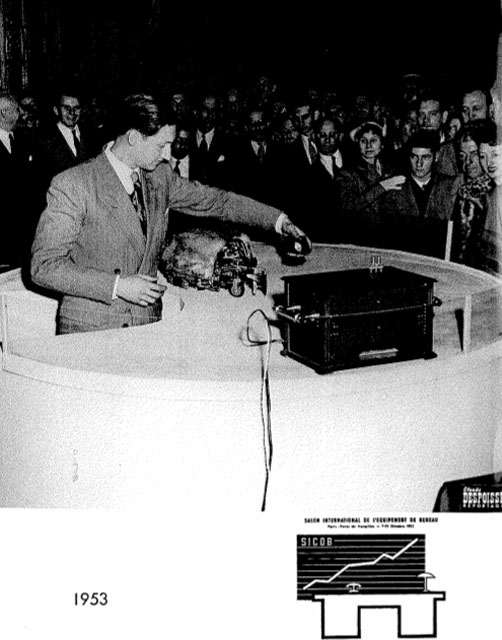
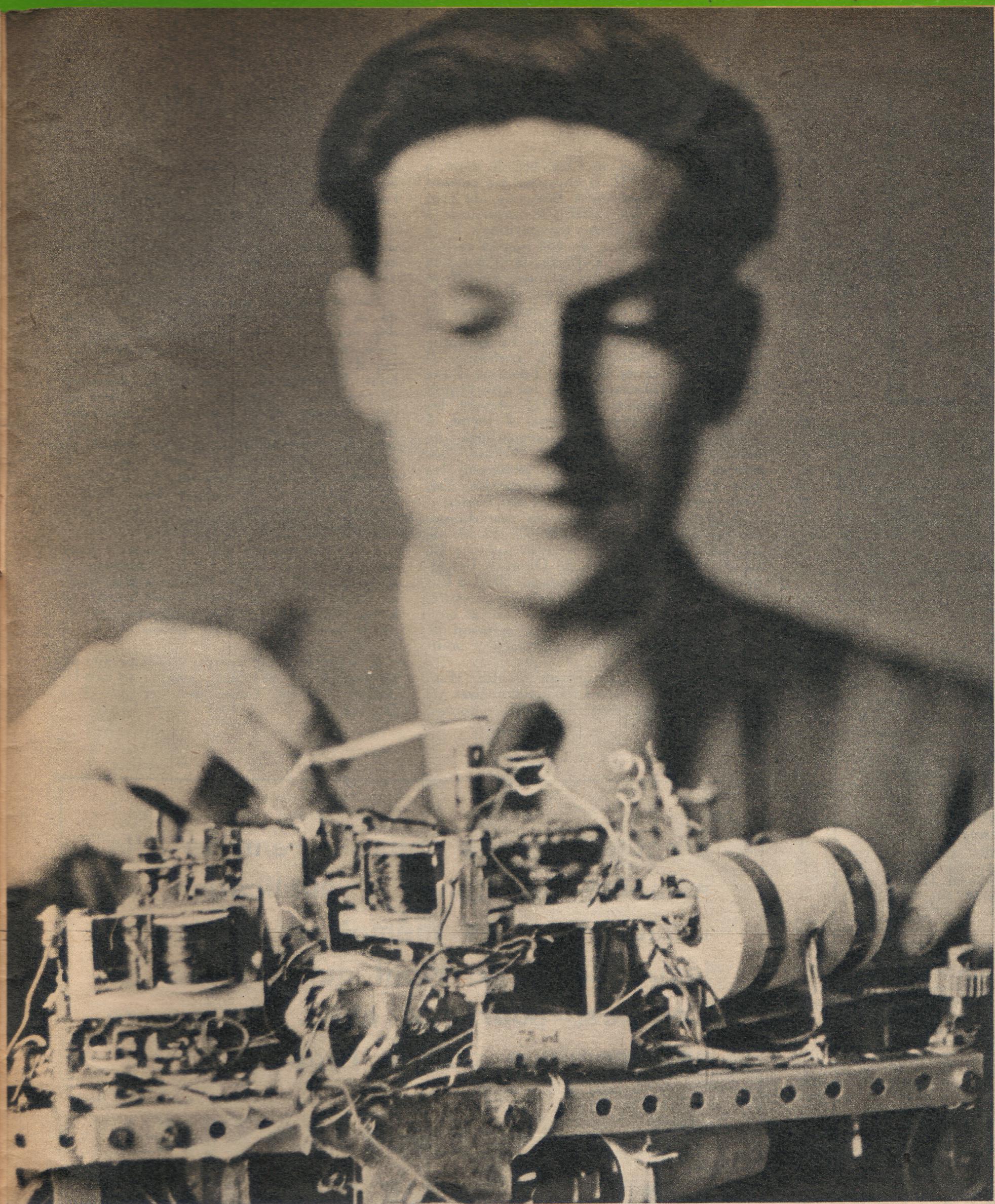
LE RENARD EU CINQ SENS
Cette adoption d'une mémoire devait nous amener à passer du réflexe à l'acte cérébral proprement dit. Nous avons en l'occurrence dégagé le caractère automatique du réflexe tel qu'on le trouvait dans le chien de Piraux aussi bien que dans les tortues de Grey
Walter, la perception commandant automatiquement une action, de même que dans le réflexe humain on sait que la perception ne va pas jusqu'au cerveau: dans la moelle épinière se trouve bien en effet une synthèse du présent et du passé, son comportement étant fonction de ce qu'il voit et de ce qu'il a vu. Ainsi nous est il apparu que l'on reproduirait un modèle élémentaire de véritable cerveau artificiel si l'on faisait en sorte qu'à chaque instant la décision se présente comme une résultante complexe des impressions senso rielles du présent et des souvenirs emmagasinés dans une mémoire, et c'est ce problème que nous avons tenté de résoudre avec le renard électronique.
L'anatomie motrice de celui ci est classique. Trois roues le supportent selon le modèle du tricycle, la roue avant étant directrice et motrice, tandis que des « compte tours » sont associés à l'une des roues arrière. Et la roue avant se trouve au dessous du cou de l'animal, celui ci portant à l'extrémité d'un support isolant un ensemble d'organes constituant la tête du renard. La tête en question a un champ d'exploration de 180°, exigeant évidemment que le moteur d'exploration soit doté d'un inverseur de marche. Celui ci intervient auto matiquement lorsque la tête se trouve à bout de course, complètement tournée à droite ou à gauche, ou encore lorsque, l'animal étant en période d'exploration, un obstacle latéral vient s'opposer au mouvement de sa tête.
Quant au moteur de marche monté sur la roue avant, nous l'avons choisi assez puissant en raison tant du poids assez élevé du renard (4 kg) que de l'intérêt d'obtenir un appareil n'ayant pas un déplacement trop lent afin que l'observation n'en soit pas fastidieuse. La capacité des accumulateurs est modeste (8 volts; 6 AH), mais heureusement ce moteur de marche ne travaille que de façon discontinue: lors de l'exploration, la consommation totale du renard est de l'ordre de 1 ampère seulement, et elle est encore moindre en période de « réflexion ».
En l'occurrence, l'organe fondamental décidant des mouvements du renard est un « inverseur de régime » qui dirige le courant des accumulateurs vers le moteur de marche ou bien l'envoie dans un circuit où le moteur d'exploration est monté en série avec un autre moteur, dit « caractériel », dont nous allons incessamment expliquer le rôle. Un tel inverseur de régime est évidemment commandé par un relais inséré à la sortie des postes électroniques qui constituent le cerveau du renard.
Celui ci est alimenté par les circuits en provenance des organes sensoriels, selon une « conjugaison » aussi vaste que possible des impressions recueillies. Certes, elle ne peut être totale. Supposons que le renard avance dans une direction déterminée et que
brusquement un obstacle soit interposé sur son chemin: obligatoirement il doit s'arrêter.
Autrement dit, il faut que le sens tactile ait « priorité » sur les autres. Telle fut la formule adoptée dans toutes les réalisations antérieures. Au contraire,pour les impressions sensorielles et auditives, il est mécaniquement possible à l'animal de marcher aussi bien que d'explorer. Autrement dit, si l'on considère les cinq sens que possède le renard, la conjugaison ne peut porter que sur trois d'entre eux, le sens tactile devant faire l'objet d'un circuit complètement autonome, tandis que pour le flair nous avons adopté une formule intermédiaire.
Une telle situation n'est pas dépourvue d'intérêt : la conjugaison des impressions en provenance de trois sens représente en effet une opération complexe reproduisant le jugement. Par example, admettons que le renard voie une lumière et sort alors dans un état tel qu'un courant de 0,51 milliampère circulé dans son relais. Admettant que ce relais ait été fermé et qu'il s'ouvre pour un courant de 0,50 milliampère, il restera fermé. L'animal aura « décidé » de marcher, mais de justesse: un son peu intense sera en effet en mesure de faire tomber momentanément le courant plaque au dessous de 0,50 milliampère, et le relais restera ensuite ouvert, car pour le « fermer » un courant de 1 milliampère est nécessaire. Les « zones critiques'» de son comportement se situent ainsi autour de 0,50 et de 1 mA, les amplificateurs ayant été réglés de telle manière que ces zones puissent correspondre à des « cas » facilement réalisés en pratique. Par ailleurs, indépendamment de cette notion de jugement, on peut dire que le sens tactile assure le réflexe, c'est à dire que, comme chez les organismes supérieurs, le comportement du renard dépend tant du réflexe que d'actes cérébraux.
En pratique, les cinq sens furent réalisés de la manière suivante :
1. La vue est assurée au moyen de deux cellules photo électriques munies d'oeillères. Grâce à cet effet directionnel, la sensation n'est pas la même avec une lumière quatre fois plus intense située à une distance deux fois moindre, comme ce serait le cas avec une seule cellule. Autrement dit, on peut avancer que ce dispositif donne dans une certaine mesure au renard la perception du relief.
2. L'ouïe consiste en un microphone; il s'agit d'un modèle rudimentaire, mais sensible, avec une pastille à grenaille utilisant le courant des accumulateurs et alimentant un transformateur couplé à un amplificateur électronique.
3. Un sens de l'orientation est représenté par un potentiomètre logé dans le cou de l'animal. Celui ci commande la polarisation d'une certaine lampe L', alors que la vue et l'ouïe commandent la lampe L, le relais sensible principal étant inséré dans le circuit plaque commun de L et L'. On voit que ce montage réalise bien une conjugaison des trois types d'impressions sensorielles jusqu'ici considérées.
4. Le toucher est assuré grâce à des papilles tactiles logées dans la tête de l'animal: il s'agit de contacts qui se ferment dès qu'un corps extérieur touche cette tête. Les contacts en question sont insérés dans un circuit contrôlant directement l'inverseur de régime.
5. Le flair consiste en une plaque métallique qui forme le museau du renard, le principe étant celui des papilles capacitives évoquées à propos de Miso. Le capaciteur qu'elles excitent commande un relais spécial qui peut agir sur l'inverseur de régime à l'instar des papilles de contact, mais ce relais est également relié au « poste caractériel ».
LE CARACTÉRIEL ET LA MÉMOIRE INTÉGRATIVE
Cependant, sous le schéma précédent nous n'avons pas encore vu apparaître la mémoire intégrative, élément numéro 1 de l'acte cérébral.
Précisons bien quelle différence fondamentale existe entre la mémoire intégrative et la mémoire simple, communément appelée enregistrement. Cette dernière formule correspond à la consignation d'une suite de signaux sur un support quelconque, suite dont on obtiendra ultérieurement la restitution par ce simple défilement dont nous trouvons l'illustration aussi bien avec le fil magnétique qu'avec le classique disque de phonographe. Au contraire, la mémoire intégrative représente une véritable synthèse des souvenirs: on peut, en l'occurrence, l'imaginer sous les espèces d'une surface initialement plane, à laquelle les différents événements viennent apporter autant de petites déformations. Ainsi tous les événements dont l'homme est le témoin depuis sa naissance le marquent ils, sa mentalité pouvant être concrétisée par l'aspect de sa surface mnémique à la suite de toutes ses déformations, dont chacune a été oubliée dans le détail.
C'est ainsi avec le caractériel que nous avons tenté de reproduire un tel principe de mémoire intégrative. Il s'agit, nous l'avons dit, d'un moteur d'exploration, donc susceptible d'être mis en marche chaque fois que les impressions sensorielles du renard atteignent le seuil d'excitation qui fait basculer l'inverseur de régime. Ce moteur est en l'occurrence couplé à un potentiomètre qui commande la tension de la grille auxilliaire du tube L'. Si cette tension est très élevée, le courant passe dans L', même si la grille principale est polarisée négativement. Au contraire, une faible tension de cette grille auxiliaire a pour effet de bloquer L'.
Grâce à ce mécanisme, il apparaît donc que les impressions sensorielles en même temps qu'elles commandent le mouvement du renard modifient le réglage de ses amplificateurs, c'est à dire que, mis devant une situation identique, son comportement ne sera pas le même d'un jour à l'autre, puisque le renard aura «vécu » entre temps.
Toutefois, il nous a paru judicieux que ce caractériel ne soit pas mis en marche en permanence. A cet effet, nous l'avons fait dépendre d'un poste de commande capable de le court circuiter. Celui ci fait lui même la synthèse de plusieurs phénomènes, puisqu'il dépend de trois contacteurs commandés respectivement par le mouvement du caractériel lui même (ce qui revient à dire que, de lui même, le caractériel se bloque au bout d'un temps de fonctionnement déterminé), par le mouvement du renard (un inverseur étant commandé par les roues arrière) et enfin par le relais du capaciteur.
Lorsque le caractériel est en action, la sensibilité du renard se trouve modifiée et on peut dire que son caractère varie. Au contraire, quand il est court circuité, le caractère est fixe, ou du moins ne peut plus évoquer que des « variations d'humeur », selon la tension aux bornes des accumulateurs. Cette tension, qui commande directement la polarisation de la lampe L', est en effet fonction tant de l'état de décharge des accumulateurs que de l'énergie demandée par les moteurs et bobinages divers.
Si la décision prise par le renard devant une situation donnée représente ainsi une synthèse du présent et du passé, il est à noter que le « poids » de ce passé est variable selon la position de la tête. Nous avons en effet indiqué que le mouvement de celle ci agit sur un potentiomètre commandant la lampe L', la sensibilité de ce tube étant ainsi très grande quand la tête est droite, et au contraire faible si la tête est complètement tournée à droite ou à gauche. De même, il apparaît que, selon les individus, le poids du passé est plus ou moins grand selon leur tempérament tous les degrés étant possibles de l'hédoniste au contemplatif tandis que, pour un individu donné, la part du passé varie également selon les circonstances.
Ainsi, lorsque le renard regarde droit devant lui, peut on dire qu'il vit essentiellement sur sa mémoire, tandis qu'il tient surtout compte de ses perceptions quand sa tête est tournée.
UNE DISCONTINUITÉ DE LA PERCEPTION
Signalons simplement, sans discuter ici cette question, que nous avons voulu introduire une cellule d'imagination dans ce renard, tandis qu'il parle un langage binaire, grâce à deux ampoules respectivement verte et rouge portées par sa tête.
Mais surtout, nous avons tenté de reproduire une analogie supplémentaire avec le cerveau humain en adoptant le principe d'une perception discontinue, cette discontinuité étant d'une importance capitale chez nous, En l'occurrence, notre cerveau peut être considéré comme une machine travaillant en vase clos, sauf durant de courts intervalles qui se répètent au rythme de 10 à 12 par seconde, au cours desquels des informations sont précisément cueillies dans nos aires cérébrales. Au demeurant, ce rythme nous explique bien que notre oeil voit les images si elles se succèdent à raison de quelquesunes par seconde, tandis qu'au dessus d'une douzaine c'est le « cinéma »; de même notre oreille perçoit un son si les bruits successifs obéissent à une loi analogue. En réalité, ce n'est ni notre oeil ni notre oreille qui doivent en être rendus responsables, mais bien le cerveau, celui ci prenant connaissance du monde de façon discontinue pour modifier son travail en fonction des nouvelles informations recueillies.
Pour réaliser une telle discontinuité dans le renard, nous avons fait appel à ces « comptetours » solidaires d'une roue arrière, dont il a précédemment été question. Ainsi, un contacteur primaire se trouve fermé tous les trois tours, qui bloque un relais mémoire susceptible d'être débloqué seulement si une cause influe sur le mouvement de la tête. D'autre part, un contacteur secondaire est fermé tous les six tours. Or, la fermeture de ces deux contacteurs a pour effet de mettre en marche le moteur d'exploration et le caractériel, tandis que toutes les perceptions sont coupées, cet état de choses subsistant jusqu'à ce que l'un des deux contacteurs soit ouvert. Cela se passera en pratique si la tête rencontre un obstacle latéral ou, à défaut, en fin de course, c'est à dire lorsque la tête, complètement tournée d'un côté, est amenée à changer son sens d'exploration. A ce moment, le renard voit alors le monde extérieur avec un esprit nouveau, puisque nous avons signalé que c'est justement en fin de course que le poids du passé est minimum…
Si ce renard prétend reproduire les caractéristiques fondamentales du travail cérébral, comprenons toutefois qu'il s'agît d'un « modèle réduit » élémentaire, tant au stade de la perception qu'à celui du jugement : ses deux cellules photo électriques apparaissent en effet comme des accessoires bien pauvres en regard des 140 millions de cellules que porte notre rétine. Et d'autre part, il est acquis que notre cerveau possède quelque 10 milliards de neurones!
A ce titre, il est certain que nous avons à peine entrevu des possibilités qui s'annoncent fantastiques. Et d'ailleurs, par le passé, nombre de constructeurs d'automates nous ont montré toute la subtilité de comportement que l'on peut attendre d'une machine si l'on a la patience de l'aménager en conséquence. Le nom prestigieux de Vaucanson est là, avec ses automates merveilleux : si l'on considère seulement une « aile » du fameux canard, n'oublions pas qu'elle comportait 400 éléments, tandis que le même Vaucanson sut construire pour la représentation du « Cléopâtre » de Marmontel un serpent qui s'élançait à travers la scène en sifflant et allait avec une étonnante précision percer le sein de la reine. Et les constructeurs d'automates ignoraient cet agent merveilleux qu'est l'électricité, âme des organes sensoriels et des moteurs actuels! On peut se demander quelles machines ils auraient réalisées avec les ressources de l'électronique moderne.
Justement, la technique nous fait aujourd'hui pénétrer dans cette ère de la véritable « horlogerie électronique » où l'on peut construire des tubes de la taille d'un pois, avant d'avoir demain des transistors gros comme une aiguille de phonographe. Dans la montre électrique, ne voyons nous pas d'autre part un moteur électrique et une pile offrant 1 aspect de simples pastilles ? Sous ce signe, on peut espérer demain construire des cerveaux électroniques de la dimension d'un cerveau humain, c'est à dire que de véritables miracles sont à attendre en matière d'animaux électroniques, au delà desquels notre bricolage actuel apparaîtra d'une pauvreté déconcertante.
Quant à l'intérêt de tels animaux artificiels, il nous semble considérable. D'abord leur utilité théorique est réelle, véritables machines à analogies nous permettant les plus intéressantes études sur le fonctionnement de notre système nerveux. Surtout, nous croyons qu'inéluctablement, à côté des machines à calculer et des cerveaux électroniques sans cesse plus complexes sur lesquels l'homme se repose de plus en plus pour résoudre un nombre croissant d'opérations intellectuelles, la terre se peuplera demain d'un grand nombre de robots dotés de facultés motrices: prolongeant la formule de ces animaux artificiels, ils représenteront ainsi un peuple d'esclaves aptes' à exécuter toutes tâches matérielles dont l'homme entendra les charger, sous les espèces des
races les plus diverses…
Ainsi, ALBERT DUCROCQ
Google translation (uncorrected)
THE FIVE SENSES EU RENARD
The adoption of a memory should lead us to spend reflex in the brain act itself. We have in this case reached the automatic reflex as it is found in the dog Piraux as well as turtles Grey
Walter, the perception Commander automatically action, as well as in the human reflex we know that the perception does not go to the brain: in the spinal cord itself is in fact a summary of the present and the past, its behavior depending what he sees and what he has seen. Thus it is apparent that we reproduce a model elementary artificial brain true if one was sure that at any moment the decision is a result of complex sensory impressions of this cutting and memories stored in a memory , and it is this problem that we tried to address with the fox-mail.
The anatomy of the motor is classic. Three-wheeled support it based on the model of tricycle, the front wheel is director and
Driving while "taking turns" are associated with one of the rear wheels. And the front wheel is below the neck of the animal, the latter bearing at the end of an insulating support a set of bodies constituting the head of the fox. The head in question has a field of exploration of 180, demanding course that the engine is crawling with an inverter walk. The order is automatic when the head is at the end, completely turned to the right or left, or when the animal is in a period of exploration, an obstacle comes oppose the lateral movement of his head.
As for the running engine mounted on the front wheel, we have chosen powerful enough because of both the relatively high weight of the fox (4 kg) than in the interest of obtaining a device with no moving too slow to that the observation is not tedious. The capacity of batteries is modest (8 volts; 6 AH), but luckily this engine running works only so discontinuous: when drilling, the total consumption of the fox is in the order of only 1 amp, and it even fewer in times of "reflection".
In this case, the basic body movements deciding fox is a "reverser system" that directs the flow of battery to the motor running or sends in a circuit where the engine is mounted exploration in series with another engine, said "character", which we will shortly explain the role. Such an inverter system is obviously controlled by a relay inserted at the exit of the posts that make up the electronic brain of the fox.
This one is fed by the circuits from the sensory organs, according to a "combination" as broad as possible impressions gathered. Admittedly, it may not be complete. Suppose that the fox advance in a certain direction and that
Suddenly be an obstacle placed in his path: he must necessarily stop.
This means that the tactile sense is "priority" over others. That was the formula adopted in all the past achievements. On the contrary, for the hearing and sensory impressions, it is mechanically possible for the animal to walk as well as to explore. In other words, if we consider the five senses that owns the fox, the combination may only refer to three of them, the tactile sense to be a completely autonomous circuit, while the flair we have adopted an intermediate.
Such a situation is not devoid of interest: the combination of impressions from three senses is indeed a complex reproducing judgment. For example, assume that the fox track and a light comes up in a state such as a current 0.51 milliamp circulated in the relay. Accepting that this relay has been closed and it opens to a current of 0.50 milliamp, it will remain closed. The animal has "decided" to walk, but only just a little intense it will indeed be able to bring down the current plate momentarily below 0.50 milliamp, and the relay will then remain open, because for the "close "a current of 1 milliamp is necessary. The "critical areas' of his behaviour and lie around 0.50 and 1 mA, amplifiers have been resolved in such a way that these areas may correspond to" case "easily achieved in practice. In addition, regardless of the concept of judgement, we can say that the tactile sense ensures reflex, ie, as in higher organisms, the behaviour of both the fox depends reflex that acts brain.
In practice, the five senses were made in the following manner:
1. The view is provided through two photo electric cells fitted with blinkers. Through this way, the sensation is not the same with a light four times more intense, at a distance twice less, as would be the case with a single cell. In other words, it can be argued that this gives to some extent the fox the perception of the terrain.
2. Hearing consists of a microphone, it is a rudimentary model, but sensitive, with a pellet shot at using the current Battery and feeding a transformer coupled to an electronic amplifier.
3. A sense of direction is represented by a potentiometer housed in the neck of the animal. He then brought to the polarization of a certain lamp L ', while the sight and hearing are ordering the lamp L, the main one being sensitive relay inserted in the circuit plate Joint L and L'. We see that this assembly performs well a combination of three types of sensory impressions so far considered.
4. The touch is ensured by the papillae tactile housed in the head, the animal it is that close contacts as soon as a body outside touch this head. The contacts in question were inserted into a circuit directly controlling the inverter system.
5. The flair is a metal plate which forms the nose of the fox, the principle being that the papillae capacitive raised about Miso. The Capacitor they excite a relay special command that may act on the reverser system like the taste of contact, but this relay is also linked to the "post character." [Note RH – This is the so-called “sense of smell” – not real smelling at all.]
THE MEMORY AND CARACTÉRIEL INTEGRATIVE
However, under the previous scheme we have not yet seen the memory integrative, element number 1 of the Act cerebral.
Note well what fundamental difference between memory and integrated memory simple, commonly known recording. This formula corresponds to the recording of a sequence of signals on any media, as a result of which there will subsequently recover from this simple scroll which we find illustrated both with the wire with the conventional magnetic disk phonograph. Instead, the memory is a true integrative synthesis of memories: one can, in this case, imagine under the appearances of a surface initially plane, in which the various events just make as many small deformation. Thus all the events in which man has witnessed since its birth as they mark his mentality can be achieved by the appearance of its surface mnémique as a result of all its strains, each of which has been forgotten in detail.
Thus with the character that we tried to reproduce such a principle integrative memory. It is, as we have said, with an engine of exploration, and so is likely to be turned on whenever the sensory impressions of fox reach the threshold of excitement that toppled the regime reverser. This engine is in this case coupled with a knob that controls the voltage of the grid auxiliary tube '. If this tension is very high, the current passes through L ', even though the main gate is biased negatively. Instead, a low voltage of the auxiliary gate has the effect of blocking L '.
Through this mechanism, it appears that the sensory impressions at the same time they control the movement of foxes change the setting of its amplifiers, ie, faced a similar situation, his behaviour is not the same from one day to another, since the fox has "lived" in the meantime.
However, we felt it appropriate that this character is not turned on at all times. To this end, we did it depend on a command post capable of short-circuiting. He makes himself the synthesis of several phenomena, it depends on three contacts controlled by the movement of the character itself (which means that, in itself, the character hangs at the end of a time Operating determined), by the movement of fox (an inverter is controlled by the rear wheels), with the relay of Inductor.
When the character is action, the sensitivity of the fox is changed, and we can say that it is varied. On the contrary, when it is short-circuited, the character is fixed, or at least can no longer mention that "variations in mood," according to the voltage of the batteries. This tension, which directly controls the polarization of light ', is indeed a function of the state of discharge of batteries that the energy required by the engines and various windings.
If the decision by the fox to a given situation represents a synthesis of the present and the past, it should be noted that the "weight" of the past is variable depending on the position of the head. We have in fact indicated that the movement thereof acts on a potentiometer commander lamp L ', the sensitivity of the tube being so great when the head is right, and on the contrary low if the head is completely turned to the right or left. Similarly, it appears that, depending on the individual, the burden of the past is more or less depending on their temperament all levels with the possibility of hedonistic while the contemplative, for a given individual, the part of the past also varies depending on the circumstances.
So when the fox look straight ahead, can we say he lives primarily on his memory, especially as he takes on his perceptions when his head is turned.
A DISCONTINUITÉ OF PERCEPTION
Worth noting simply, without discussing this issue here, we wanted to introduce a cell of imagination in this fox, as he speaks for binary through two bulbs green and red respectively worn by her head.
But above all, we tried to reproduce a further analogy with the human brain by adopting the principle of a perception discontinuous, this discontinuity is of a paramount importance to us, In this case, our brain can be considered as a working machine in a vacuum, except during short intervals which are repeated at a rate of 10 to 12 per second, during which information is collected specifically in our cerebral areas. Moreover, this rate though we explained our eye sees the images if they succeed because of Brettermeier per second, while over a dozen is the cinema, and similarly our ear perceives sound if noises successive obey a similar law. In fact, it is neither our eye or our ears that need to be blamed, but rather the brain, the latter taking cognizance of the world in order to change discontinue its work in the light of new information received.
To achieve such a discontinuity in the fox, we have called these comptetours "solidarity" with a rear wheel, which he had previously discussed. Thus, a contactor primary is closed all three rounds, which blocks a relay memory likely to be released only if a cause affects the movement of the head. On the other hand, a contactor school is closed all six rounds. However, the closure of these two contacts has the effect of bringing
Engine exploration and character, while everyone's perceptions are cut, this state of affairs remaining until one of the two contacts is open. This happens in practice if the head hits an obstacle side or, at the end of the course, ie when the head turned completely on the one hand, is required to change its sense of exploration. At that moment, the fox sees the outside world with a new spirit, as we pointed out that it is precisely at the end of the race that the weight of the past is minimal …
If the fox claims reproduce the basic characteristics of cerebral work, understand that it is a "model" Basic reduced, both at the perception that the trial: two photo electric cells appear in effect Accessories well as poor against the 140 million cell door as our retina. And on the other hand, it is assumed that our brain has about 10 billion neurons!
As such, there is no doubt that we have barely glimpsed the fantastic opportunities that lie ahead. And indeed, in the past, many manufacturers have shown us automates all the subtlety of behaviour that may be expected from a machine if you have the patience to develop it accordingly. The prestigious name of Vaucanson is there, with its wonderful machines: if we consider only a "wing" of the famous duck, we must not forget that it incorporated elements 400, while the same Vaucanson knew how to build representation " Cleopatra "Marmontel a snake that s'élançait across the stage whistling and went with astonishing precision drill with the queen. And manufacturers automata unaware that agent wonderful electricity soul of sensory organs and today's engines! One might ask what machines they would have done with the resources of modern electronics.
In fact, the technique we now enter an era of genuine "electronic watches" where one can build tubes the size of a pea, before tomorrow transistors big as a phonograph needle. In the electric shows, we can see no other an electric motor and a battery offering 1 single aspect of pellets? Under this sign, it is hoped to build tomorrow's electronic brain the size of a human brain, ie true miracles are to be expected in terms of electronic animals, beyond which our current DIY appear in a Poverty disconcerting.
As to the desirability of such animals artificial, it seems considerable. First theoretical usefulness is real, real machines analogies allowing us the most interesting studies on the functioning of our nervous system. Importantly, we believe qu'inéluctablement, besides calculating machines and electronic brains ever more complex over which man relies more and more to solve a growing number of operations intellectual grounding peuplera tomorrow ' a large number of robots that are able drive: extending the wording of these artificial animals, they represent a people capable of slaves' to perform all tasks material which man will hear the charge, under the species of
The most diverse races …
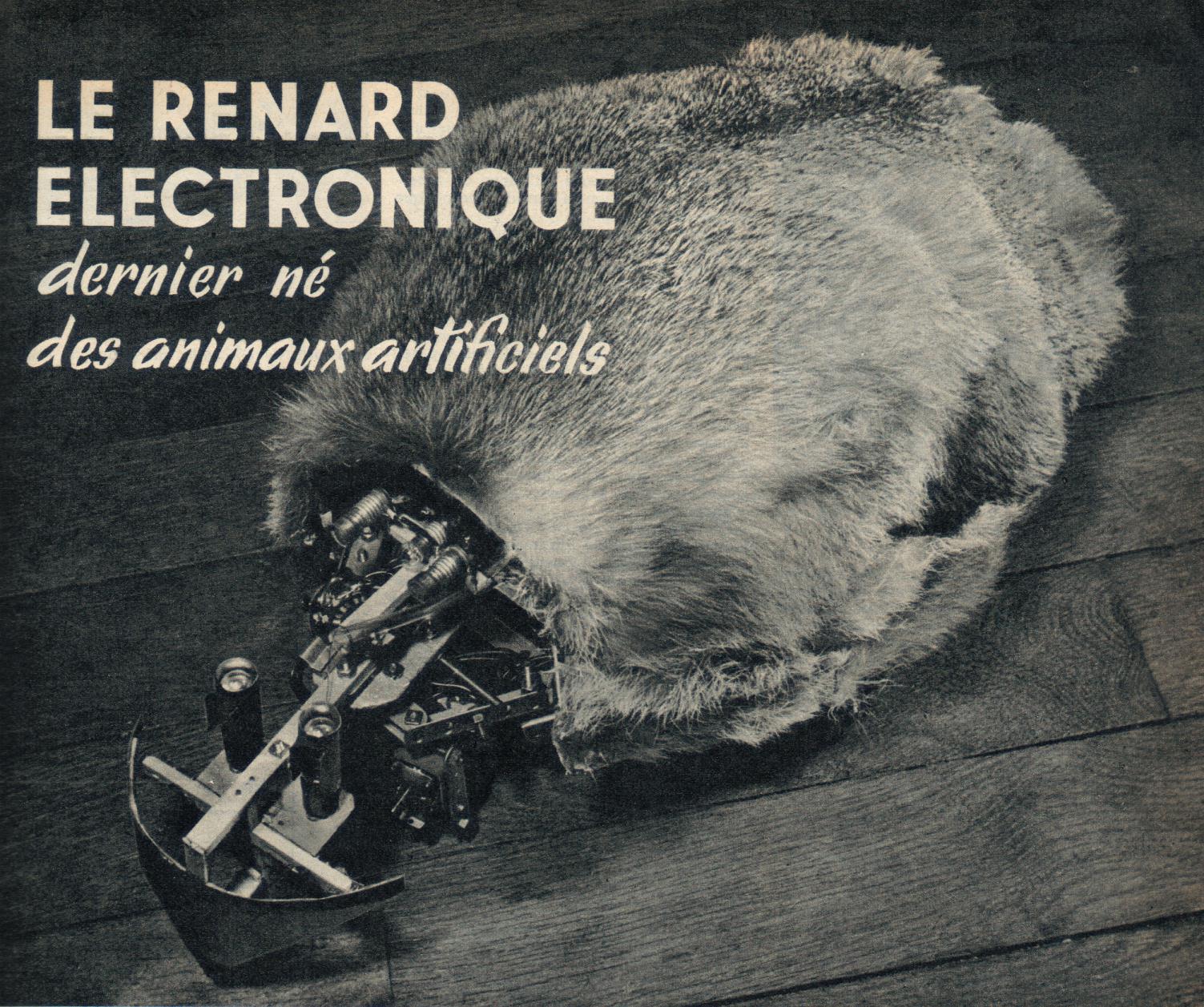
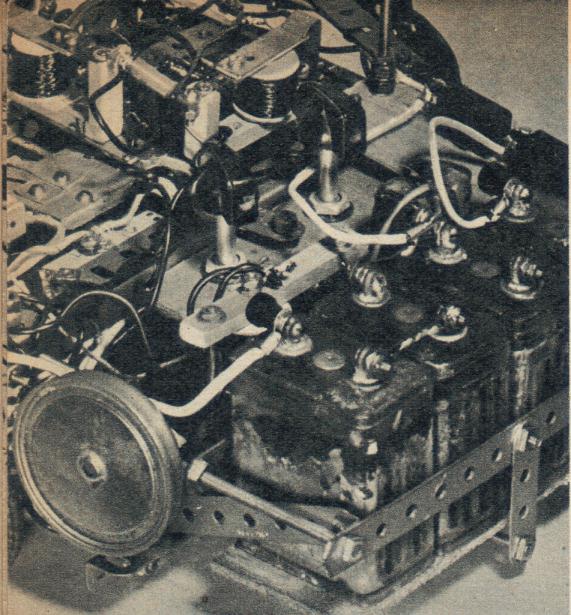
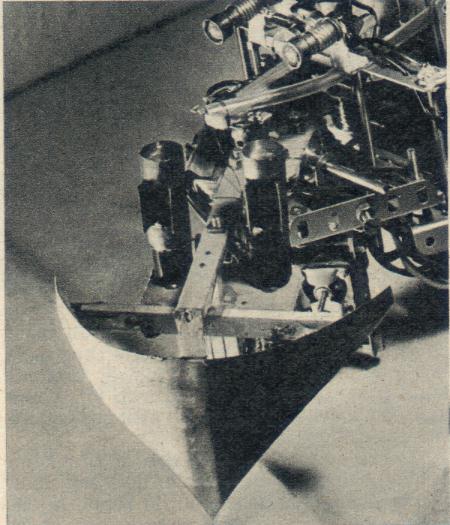
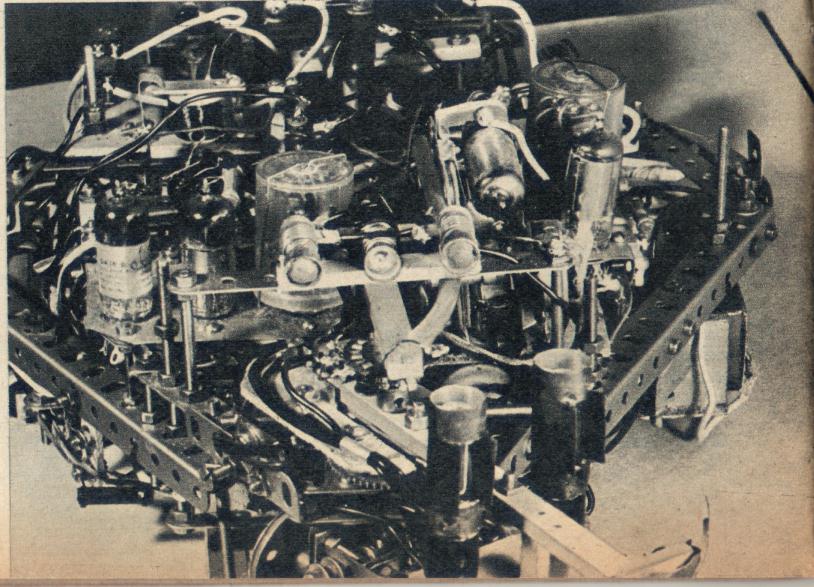
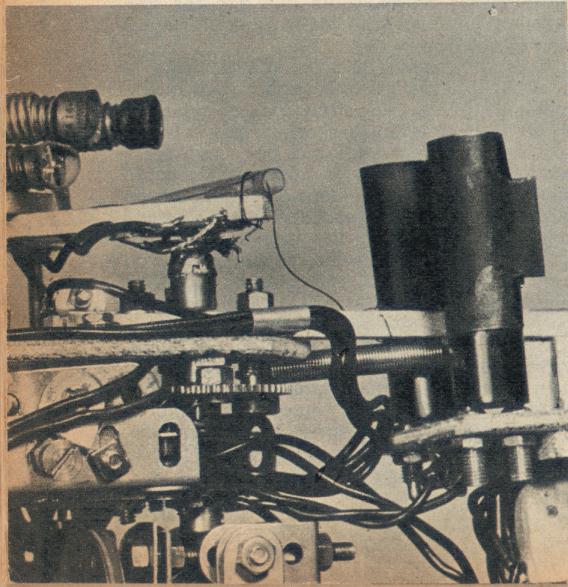
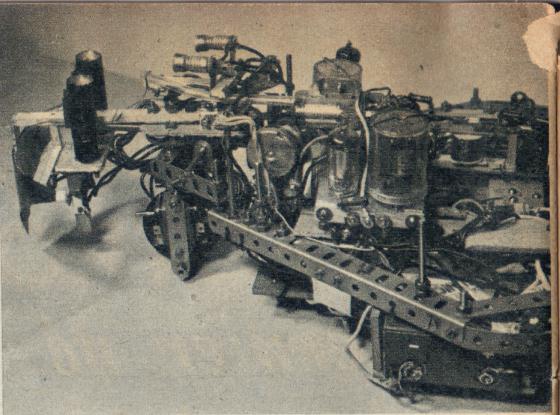
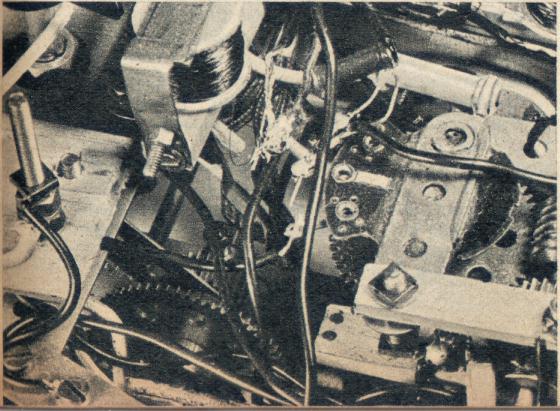
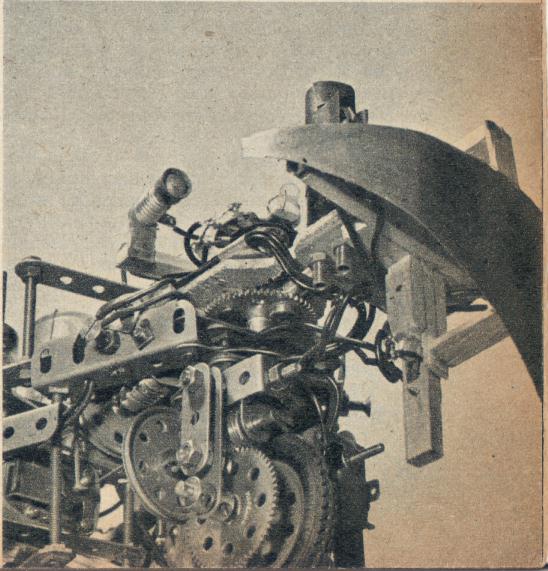

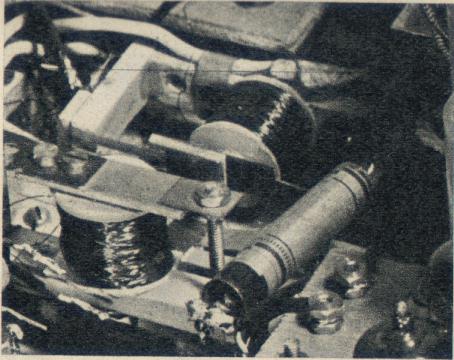

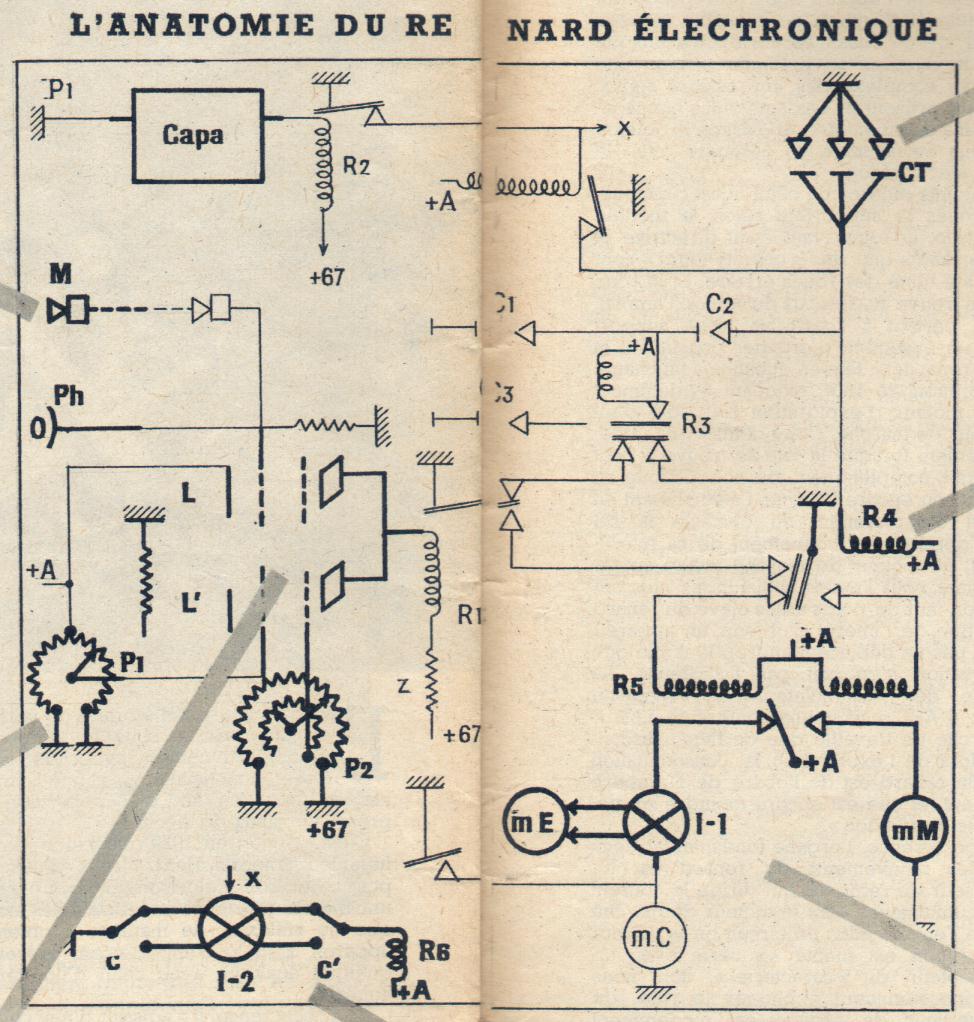
There are a few video clips of Ducrocq's constructions. I will add them in as I relocate them.
http://video.aol.com/video-detail/id/3421418414
http://video.aol.com/video-detail/id/3531747542
As it is today…. (image from Arts et Metiers site here)

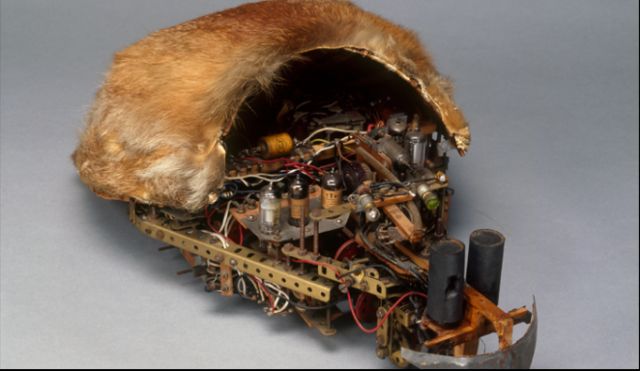
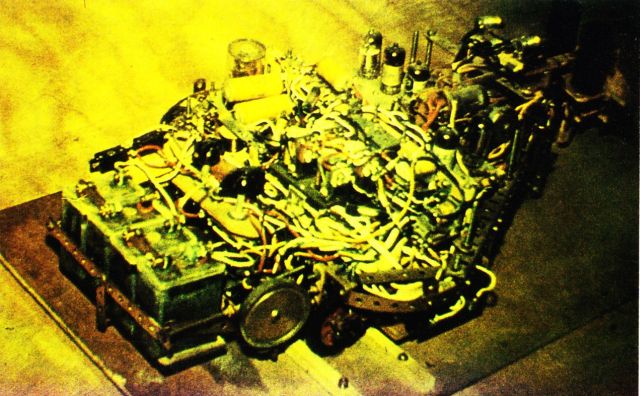
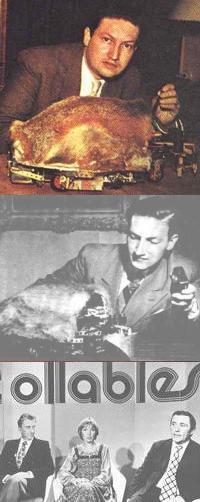
In May 2009, David Buckley and I visited the Arts et Metiers archive to see Job. Together we took many detailed photographs of Job. Here are a couple – note that they are for academic and research purposes only, NOT commercial.
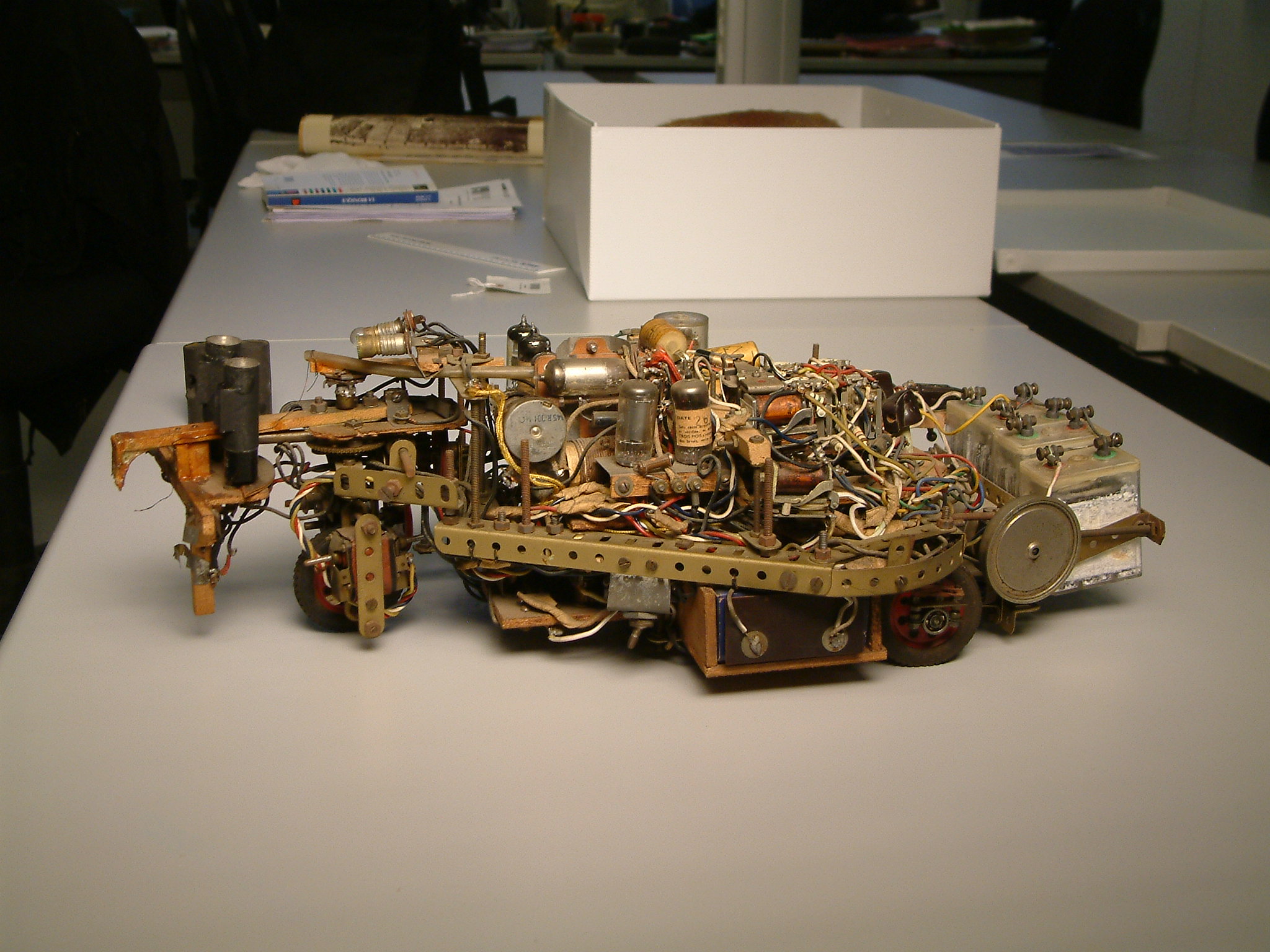
Ducrocq also constructed a remote control vehicle. All I have are a few stills from a video clip (see Gaumont here and register to view clip).
CHALLENGE: someone to write down an English – version of what's being said in the various video clips.
TRIVIA: Albert Ducrocq's naming convention behind his Miso family members is worth a mention.
It helps to know your Latin when it comes to Ducrocq’s names for his cybernetic zoo. "Miso," signifying hatred of something (hence repulsion), the opposite is "Philo," lover of something (hence attraction).
Those names intrigued me. Whilst searching internet for them, more often than not I was getting hits, but they were not the 'renards'. What it appears to be is that Ducrocq, the scientist, used a remembering technique for mnemonics of a syllogism.
syllogism, a form of logical argument that derives a conclusion from two propositions (‘premises’) sharing a common term, usually in this form: all x and y (major premise); z is x (minor premise); therefore z is y (conclusion). For example: all poets are alcoholics; Jane is a poet; therefore Jane is an alcoholic. In this deductive logic, the conclusion is of course reliable only if both premises are true.
An example is: all horses have tails; all things with tails are four-legged; so all horses are four-legged. Each premise has one term in common with the conclusion, and one term in common with the other premise. The term that does not occur in the conclusion is called the middle term. The major premise of the syllogism is the premise containing the predicate of the conclusion (the major term), and the minor premise contains its subject (the minor term). So the first premise of the example is the minor premise, the second the major premise, and ‘having a tail’ is the middle term. The four kinds of proposition distinguished in syllogistic reasoning are universal affirmatives (all men are mortal), called A propositions, particular affirmatives (some men are sick), called I propositions, universal negatives (no men are trustworthy), called E propositions, and particular negatives (some men are not lawyers), called O propositions. This enables syllogisms to be classified according to the form of the premises and the conclusions (see also square of opposition). The other classification is by figure, or way in which the middle term is placed in the premises. The conclusion is always of subject-predicate (S-P) form, and the middle term is M. The four figures are illustrated in the diagram:
The example given was a syllogism of the first figure. Mnemonics, in the form of names with the vowels indicating the A, E, I, O, forms, help students to remember the valid forms, called moods of the syllogism. Valid syllogisms of the first figure are Barbara (AAA), Celarent (EAE), Darii (AII), and Ferio (EIO); of the second, Cesare, Camestres, Festino, and Baroco; of the third, Darapti, Disamis, Datisi, Felapton, Bocardo, and Ferison; and of the fourth, Bramantip, Camenes, Dimaris, Fesapo, and Fresison.
The words Felapton, Cesare, and Barbara are some of the mnemonic names invented in the thirteenth century, and found in the “Summulæ” of Petrus Hispanus (Pope John XXI., died 1277).
Job
Job was a God-fearing man who avoided evil, had seven sons and three daughters, and was immensely wealthy. God calls Job "A good man who fears God and will have nothing to do with evil." (Job 1;8). Satan scoffs, "Why shouldn't he when You pay him so well? … You have always protected him and his home and his property from all harm." God then allows Satan to do anything he likes with Job's wealth, but not to harm him physically.
A series of misfortunes strikes Job. Three friends visit him, Eliphaz, Bildad, and Zophar, and each try to explain Job's misery in a different way. There are three speeches by each of the three friends.
A fourth man Elihu, tries to summarize the situation, offering yet another explanation of why Job is suffering. Finally the Lord Himself speaks to Job, and Job recognizes that we do not always need answers to life's problems but that we always need God Himself. Job is then healed and given material and spiritual blessings far beyond his former state.
The life and times of Job are contained in the Bible's book of Job, in the Old Testament. The theme of this book is that mankind simply does not have enough knowledge to explain why things happen the way they do. It is possible to rise above our limitations by faith in God, however, because God does know why everything happens and will work good for those who love him. We may thus learn the profound truth that when we have nothing left but God, God is enough.
I suspect Ducrocq is having a small joke on us as he sees himself as the “creator”.
See other early Cybernetic Creatures and Models here.
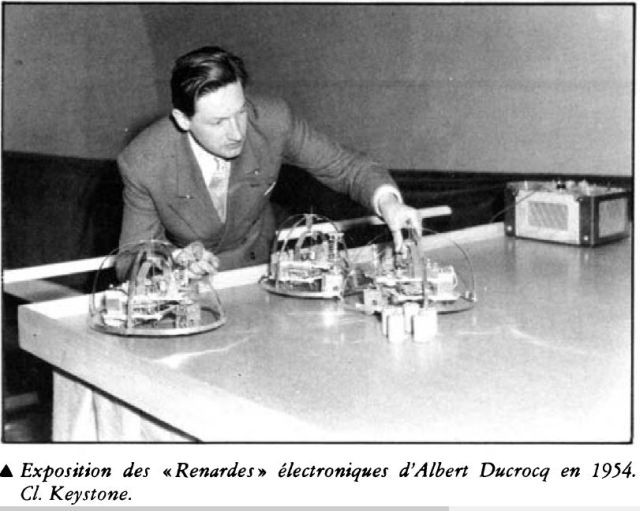
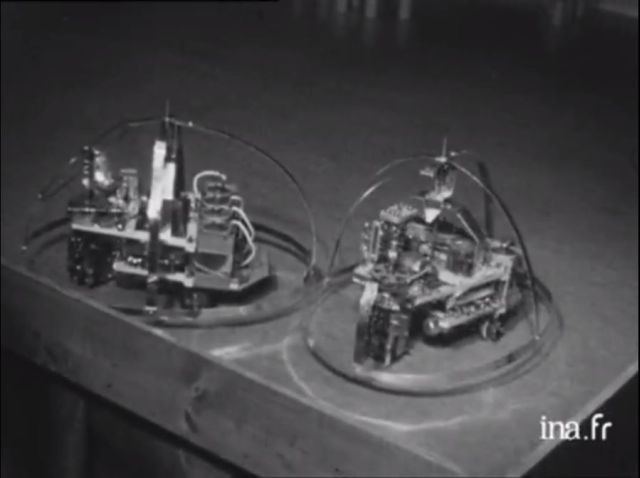
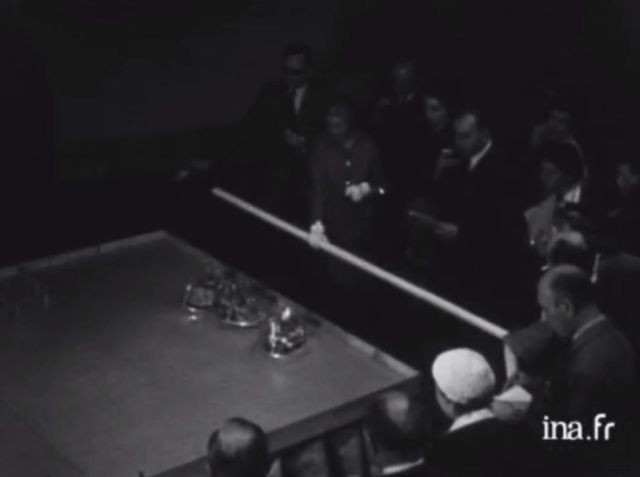
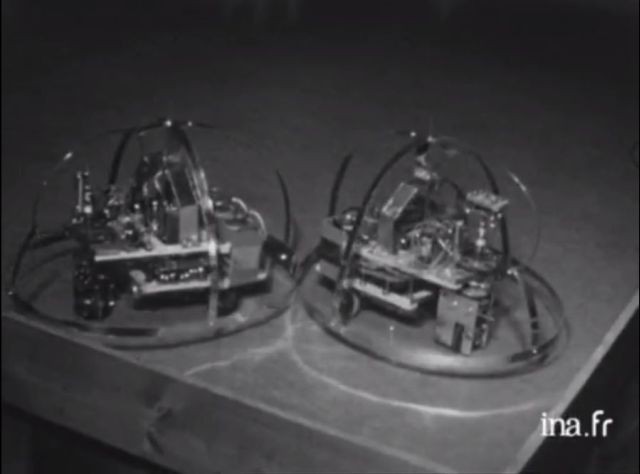
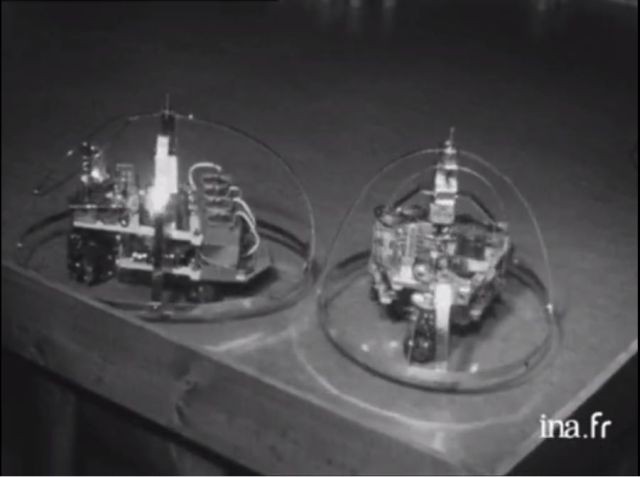
I have linked to this article from our Meccano club site. Meccano in the first steps of robotics!